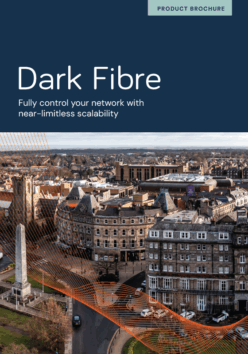On Thursday 10th June, I was delighted to participate in a virtual event held by Host in Scotland, the body established to represent and promote data centres across the country and forming a key part of Scotland’s digital future. Chaired by the organisation’s founder, James King, I was joined by representatives from Moy Materials, Iomart and Ciena, but the presentations began with a view on the importance of the data centre in modern e-commerce from Will Ringer at ARC:MC.
Will kicked off the event by explaining that we are currently in the midst of very turbulent times, in which industry is challenged by the demands of decarbonisation targets, a burgeoning requirement for the rapid transfer of data and revolutionary changes in employee working environments. Combined, these lead to an increased reliance on data centres and major changes in the strategy of building new facilities.
With environmental targets in mind, the data centre is rapidly becoming integral in driving efficiencies and enabling green processes to work effectively. An example of this might be with the generation of power and its transmission across smart grids in the energy and utilities sector. In this scenario, the transfer of real-time data from sensors and smart infrastructure is imperative in ensuring the production of electricity is optimised, and carbon footprints are minimised.
Meanwhile, some businesses are now building supply chain facilities closer to their main sites in order to aid efficiencies. This is especially prevalent in the manufacturing sector. The same thinking applies to the location of new data centres, and it’s becoming more commonplace to find these built as part of the same complex as their anchor tenants. The close proximity of the data centre is important in reducing latency in the transfer of information. And with reduced space required to accommodate employees as a consequence of the COVID-19 pandemic, it’s predicted that more compact data centres will be established in more urban and inner-city locations, with floors of office blocks filled with racks of data rather than desks.
Data centres: How do they enable industrial progress?
Data centres now form a central part of local and regional ecosystems. Their proximity to industries is imperative in the growth of economies and the proliferation of job opportunities. Will’s presentation not only brought this transition to light, but also brought about the notion of ecosystems underpinning the digital economy of nations.
This was echoed in the presentation delivered by Cathal Quinn and Brian Conroy of Moy Materials; a construction firm specialising in roofing technology. They talked of the need to build data centres with both domestic and global regulations in mind, as well as the universal requirement to be more environmentally friendly. As such, they have developed solutions to diminish the reliance on power to cool data centres, as well as condition monitoring technology to detect roof leakage or structural faults in real time.
It’s this kind of technology that relies upon the core connectivity services offered by Neos Networks, further demonstrating the criticality of an ecosystem that works collaboratively and effectively. A point to which Reece Donovan of Iomart alluded, it’s an ecosystem which must receive commitment from both the public and private sector, with particular emphasis on supporting the local workforce and nearby organisations in driving forward the digital ambitions of the nation.
How does supporting local economy drive global investment?
This consideration of local economy is an initiative Neos Networks has prioritised in our digitisation of the Aberdeenshire council network. During my presentation I discussed in more detail how, during this build, we took on five local apprentices and upskilled the workforce in the region to ensure a timely roll-out of connectivity services. We also took the time to deliver careers presentations to schoolchildren in the region.
But on a wider scale, the CNI-grade fibre we have installed will mean data centres in the area can now perform to their full potential, and with initiatives to expand reach out to landing stations on the Scottish coastline, we are enabling connectivity options for transatlantic hyperscalers looking to route into the British Isles. In addition to this, Neos Networks are investing heavily in their exchange presence across the UK, more than doubling our reach by the end of 2021 with 550 exchanges due to be on-net, which includes an extension to our Scottish footprint. By expanding our reach across the country, Neos Networks is seeking to provide largely under-served areas with premium quality fibre infrastructure, and offers backhaul from the nation’s data centres throughout the rest of the United Kingdom.
With a range of terrains across the region, we’ve had to adopt various deployment methods in order to deliver on this project, but it’s flexibility such as this which breeds success and contributes to the maintenance of the ecosystem driving innovation and improvement of Scotland’s digital infrastructure. However, my colleagues on the call seemed to concur that greater flexibility from all those operating within the ecosystem would be welcomed.
Greater government focus on regulation
One crucial part of this would be a review of legislation. To date, regulation has provided fibre suppliers with access to the Dark Fibre network, exchange connectivity and PIA infrastructure owned by Openreach, but there are still obstacles to overcome if all are to benefit. For example, there are no options to commercialise or grow the Dark Fibre infrastructure beyond an initial customer and end point, and with PIA, the OPEX can still be prohibitive when attempting to provide compelling Dark Fibre economics to the end customer.
Like all those presenting at the event, Neos Networks is committed to supporting the digital economy of Scotland.
- We believe in the opportunity for Scotland and we are focused on supporting the ambition by bringing ubiquitous Dark Fibre network reach across the country.
- We fully support carbon neutral targets for Scotland by continuing to focus on enabling the digital grid programme in the energy sector.
- We can build on our existing customer base relationship with data centre owners, hyperscalers and MNOs to help grow the gigabit economy in Scotland.
- We will always consider the community benefit as a top priority.
The landscape of Scotland requires expert engineers and field forces, with specialist tools and vehicles to deploy infrastructure at significant cost compared to standard builds. Neos Networks is experienced and equipped to design, deploy and maintain networks in the region. But we do need help to bring Dark Fibre economics to the public sector, the MNOs and the data centres through government-led regulation. I am confident that with this in place, the ecosystem driving forward Scotland’s digital future will be running as smoothly and efficiently as possible.






